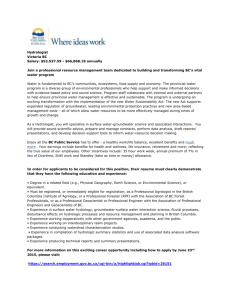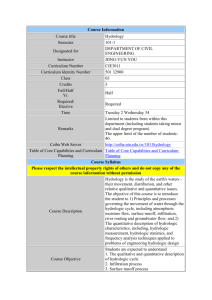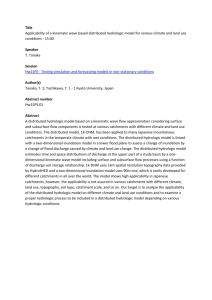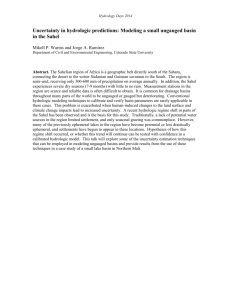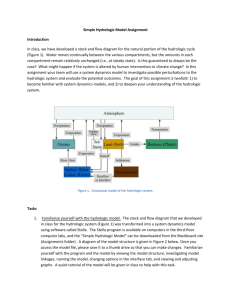Hydrologic Analysis of Lakewood - Brian Anderson
advertisement
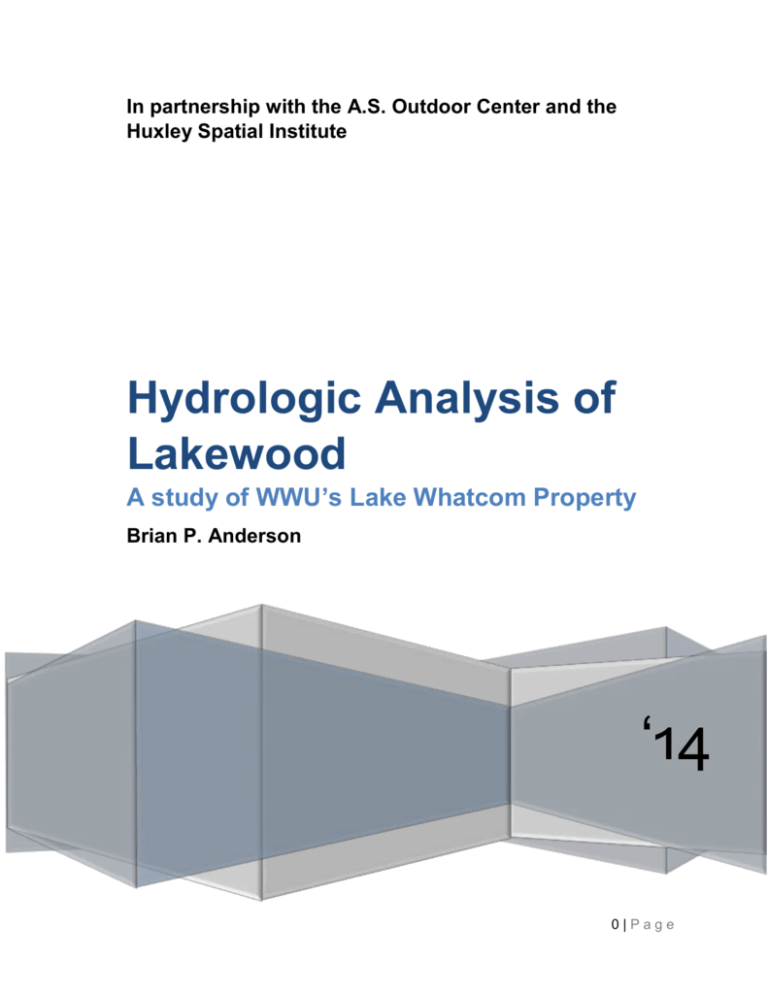
In partnership with the A.S. Outdoor Center and the Huxley Spatial Institute Hydrologic Analysis of Lakewood A study of WWU’s Lake Whatcom Property Brian P. Anderson ‘14 0|Page Brian Anderson W00928851 ENVS422 Table of Contents Introduction ................................................................................................................................. 1 Literature Review ......................................................................................................................... 2 Methods ...................................................................................................................................... 4 Data ........................................................................................................................................ 4 Analysis................................................................................................................................... 5 Results ........................................................................................................................................ 6 Discussion ................................................................................................................................. 8 Works Cited ............................................................................................................................... 9 Figure 1 - Model of analysis ....................................................................................................... 6 Figure 2 - Topographic map of Lakewood property .................................................................... 7 Figure 3 - Stream flows through Lakewood ................................................................................ 7 Figure 4 - Tree survey results .................................................................................................... 8 Introduction In the world of Geographical Information Systems/Sciences (GIS), there are countless studies occurring to test the uses of GIS’s in various areas, such as in archeology, erosion and hydrology modeling. In the field of archeology, GIS is being used to reconstruct prehistoric lakes, manage and display Native American artifact discoveries both past and present, and discovering patterns within 16 century-with gauges old cemeteries. In hydrology modeling, progress is being made in the accuracy of modeling water flows, determining watersheds and catchments. This research leads to progress in erosion modeling. The following paragraphs outline some of these hydrologic and erosion modeling studies. All of this will be used to accomplish several goals. The first will be to conduct a hydrologic analysis of Western Washington University’s Lake Whatcom property, Lakewood. The second will be to create a topographic map of the area for use by visitors. Finally, a tree survey will be conducted, finding trees larger than six feet in diameter and ten feet tall. 1|Page Brian Anderson W00928851 ENVS422 Literature Review The purpose of GIS and Hydrologic Modeling – an Assessment of Progress was to measure the progress within the author’s study area, four years after the initial study. This then leads into the main bulk of the study; developing models to use on two types of areas. The first is a model that uses time averaging to determine flow. This model is used to determine stream flow at ungauged locations, which is particularly useful to my study as there are no gauges anywhere in my study area. This assessment also includes a non-point source pollution assessment. The second is a model that accounts for time changing the hydrologic system in question. This section includes all water sources; atmospheric, soil, groundwater and surface water collections. It also includes a section about the utilization of water. This second model is to be used on streams with gauges. The authors found that their models were able to accurately track and predict stream flows and pollution based on historical trends. This particular study is useful to me because the author outlines how to create hydrologic models for areas that do not have any volume monitoring stations. I plan on implementing some of these techniques in my study. This study also provides another model in which to base my work on, aiding in the problem-solving process when my analysis is conducted. (Maidment, 1996) The study conducted in Assessing Watershed-Scale, Long-Term Hydrologic Impacts of Land-Use Change Using a GIS-NPS Model examines the impacts of hydrologic nonpoint source pollution based on land-uses, specifically what effects changes of land-use has on water pollution. The authors created a model which assesses long-term hydrologic impacts of pollution and paired it to a GIS to assess annual average runoff and pollution of their study area. The authors found an increase in pollution based on the land-use change. This study is useful to mine because it deals with nonpoint pollution sources. Though my study does not cover the scope of pollution, the 2|Page Brian Anderson W00928851 ENVS422 models used in this study can be applied to aid in determining amounts of soil erosion based on water flow through an area. (Bhaduri, Harbor, Engel, & Grove, 2000) This study in Review of GIS Applications in Hydrologic Modeling reviews the past efforts and current trends in using Digital Elevation Models (DEMs) and GIS to perform hydrologic analysis of areas. The authors discuss different presentation methods to best convey the hydrologic processes to your audience, based on past studies. The authors also analyze the best methods to perform a hydrologic analysis, based on the studies presented in the article. They also present a method for erosion prediction and control. Rather than requiring runoff information, this method requires soil, land cover, rainfall and topographic properties. This study is useful to me because it gives me references in which to base my erosion prediction models. (DeVantier & Feldman, 1993) In their study, the authors of Comparison of the performance of flow-routing algorithms used in GIS-based hydrologic analysis calculated flow direction and water catchments for their study area. The authors studied the effects of terrain shape on water and sediment movement across a landscape, using several different algorithms to compare one to another. They also addressed problems such as the acceleration of soil erosion and nonpoint pollution. The authors concluded that all around, their models produced poor results; however one algorithm stood apart and proved important for calculating sediment transport capacity. After review, this algorithm is similar to the algorithm reviewed in the above article and will provide useful in setting up a model for erosion prediction in my study area. (Wilson, Lam, & Deng, 2007) The authors of the study in FloodwayGIS: An ArcGIS Visualization Environment to Remodel a Floodway aimed to create a model for floodway boundaries for use with FEMA and local governments. The model the authors created is to be used with a commercial GIS, ArcGIS in 3|Page Brian Anderson W00928851 ENVS422 their case, to produce a mapping algorithm based on Triangulated Irregular Network (TIN) intersections to produce the desired boundaries. These boundaries are then mapped in the Digital Floor Insurance Rate Maps to determine flood insurance rates. The authors found their model better predicted the floodway boundaries than the current models used by FEMA. This study may seem specialized and irrelevant to my study; however, the methods used in this study create a basis for my own study. Their study provides methods for determining locations of waterways and the ability to predict water flow during and after storms. The increase in water flow will also increase erosion, highlighting areas in which preventative erosion methods should be employed. (Selvanathan & Dymond, 2010) All of these studies have one thing in common: they cover large areas. My research will be confined to a relatively small area, which will pose its own problem. Hydrologic modeling is normally done on a large scale because, in hydrology, the larger area must be considered instead of the small, specific areas. To counter this, I will perform an analysis on the entire area, and then cut down my results to the study area. To further my research, I will continue to research similar studies involving hydrologic and erosion modeling. As of yet, I haven’t found any studies that encompass both models; rather the studies focus on either hydrologic or erosion modeling. Methods Data The data used in this study will come from a wide variety of sources, including data I created myself. I obtained land parcel records from the Whatcom County GIS department, which unfortunately proved to be somewhat inaccurate and manual editing of the property lines of the Lakewood site was needed. From Whatcom Transportation Authority (WTA) I received point 4|Page Brian Anderson W00928851 ENVS422 and line data that show bus routes and stops, two of which are at the Lakewood property. These data were received as text files in American Standard Code for Information Interchange (ASCII) coding and needed to be converted into vector format. From the City of Bellingham GIS website, I obtained elevation contour lines, street locations, and classification and use data. After I had edited my data received from Whatcom County GIS, I received parcel polygon data from the City of Bellingham GIS which I used to ensure I had edited my property lines correctly. The final source of data I received from an outside agency was Light Detection And Ranging (LiDAR) data from the Puget Sound LiDAR Consortium (PSLC), who received the data from the City of Bellingham and Whatcom County GIS. The PSLC acts as a LiDAR clearing house for most all data surrounding the Puget Sound. This LiDAR data will be used to create a digital elevation model (DEM) of Lakewood and the surrounding land. As part of my study I will also be collecting point data of trees meeting the specific criteria I will outline. All of my data, except for the LiDAR data which is raster, is in vector format. All data was projected or re-projected into the NAD1983 State Plane Washington North (US Feet) projection. Analysis For my study, I conducted a hydrologic analysis of the area surrounding and including Lakewood. I analyzed the surrounding area as well because the Lakewood parcel is too small of an area to perform a standalone analysis. The starting point of my analysis was to resample the DEM from three meter cells to ten meter cells. This was performed because the original data was too accurate and was not able to be successfully processed due to the large file size. Next I needed to fill in any holes in the elevation data using a “Fill” function. Then the flow direction was determined, based on the slope of each cell in my DEM. This particular piece of data was then used to complete eight other processes, including determining the lengths of streams and 5|Page Brian Anderson W00928851 ENVS422 Orders, creating a basin boundary, watersheds and catchments, accumulation rates (flow rates) and direction of water flow. To define my streams, I set a threshold of 1000 cells draining into one cell. At the end of my analysis, I produced several products, including a topographic map showing the location of streams flowing through Lakewood, with metadata on their Order. All of this data will be converted to Computer Aided Design and Adobe Illustrator formats for use by the Industrial Design students. Figure 1 - Model of analysis Results My analysis concluded that there were two streams running through the property, both on the east side of it. It was also found that they were small, both second order. My tree survey found that there are 19 trees that meet my requirements for expanding the High Ropes Challenge Course. It should be noted that trees currently being used on the course were excluded from this survey. 6|Page Brian Anderson W00928851 ENVS422 Figure 2 - Topographic map of Lakewood property Figure 3 - Stream flows through Lakewood 7|Page Brian Anderson W00928851 ENVS422 Figure 4 - Tree survey results Discussion This study was very relevant to the everyday operations of the Lakewood site. As of now, there is an interactive web map, electronic and paper topographic maps and data on tree locations to be used in the future for expanding the high ropes course. As a whole, the study failed. The analysis failed to identify the one stream that does run through Lakewood; rather, the analysis identified two streams that do not exist on the property. If one were to examine the Hillshade produced from the DEM, one would clearly identify the real stream on the west side of the property. I feel this error was created as a result of resampling the DEM to larger cell sizes. Had I resampled the cells to five meters instead of ten, I believe the analysis would have correctly identified the 8|Page Brian Anderson W00928851 ENVS422 streams. The steps I took in my analysis were valid, and worked; the errors that formed were a direct result of taking overly accurate data thus making it less accurate. However, when I changed the cell drainage threshold from 1000 to 250, the true stream did begin to form. The reason I didn’t permanently change the threshold was due to the many other ‘streams’ the analysis began to identify. A different approach to solving the data issue I had would be to use a computer with stronger processors. The reason I resampled to larger cells in the first place was that there was more data than the computers I used were able to handle. With the level of computer knowledge I have, I can also infer that there was a software problem; ArcGIS can only handle a data set so large and I believe I breached that threshold. In the future, with better software and hardware, analysis of Lakewood at three meter cell sizes is possible. In spite of the limitations above, this methodology of analysis succeeded and is valid for use in future studies. Works Cited Bhaduri, B., Harbor, J., Engel, B., & Grove, M. (2000). Assessing Watershed-Scale, Long-Term hydrologic Impacts of lane-Use Change Using a GIS-NPS Model. Environmental Management, 643-658. DeVantier, B. A., & Feldman, A. D. (1993). Review of GIS Applications in Hydrologic modeling. Hydrologic Engineering, 3-16. Flower, A. (2014, Feburary 21). Lab 6: Hydrology and Watershed Analysis. Retrieved from ENVS421: GIS Databases: https://wwu.instructure.com/courses/858924/assignments/2358190 Flower, A. (2014, Feburary 28). Lab 7: Network Analysis. Retrieved from ENVS421; GIS Databases: https://wwu.instructure.com/courses/858924/assignments/2358191 Maidment, D. R. (1996, January 24). GIS and Hydrologic Modeling - an Assessment of Progress. Retrieved from University of Texax: http://www.ce.utexas.edu/prof/maidment/gishydro/meetings/santafe/santafe.htm Mayfield, J. (2014, Janurary 24). Lakewood Presentation. Retrieved from ENVS421; GIS Databases: https://wwu.instructure.com/courses/858924/files/25959706?module_item_id=5219473 Selvanathan, S., & Dymond, R. L. (2010). FloodwayGIS: An ArcGIS Visualization Envirionment to Remodel a Floodway. Transactions inGIS, 671-688. 9|Page Brian Anderson W00928851 ENVS422 Wilson, J. P., Lam, C. S., & Deng, Y. (2007). Comparison of the performance of flow-routing algorithms used in GIS-based hydrologic analysis. Hydrological Processes, 1026-1044. 10 | P a g e


